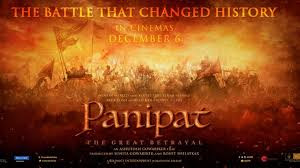#Panipat #BollywoodHindiFilmMovieReview #PicksAndPiques #JohnsonThomas Rating: * * *
Johnson Thomas
A soft-focussed Historical

Film: Panipat
Cast: Arjun Kapoor, Sanjay Dutt, Kriti Sanon, Suhasini Mulay, Mohnish Bahl,Padmini Kolhapure, Zeenat Aman, Sahil Salathia, Abhishek Nigam, Ravindra Mahajani, Gashmeer Mahajani, Nawab Shah, Mantra, Vineeta Mahesh, Krutika Deo, Shyam Mashalkar, Dishyant Wagh
Director: Ashutosh Gowariker
Rating: * * *
Runtime: 173 mins


According to Bollywood grown historians ( and we've seen it in almost every mainstream hostorical presented on the big screen in recent times ) every battle brought to screen is about unifying India and propogating the pop-patriotic sentiment - even if it be something that took place way before India ( as we know it today) was designated a country (1947). Panipat, the film, is Ashutosh Gowarker's unique way of adding more fuel to that ideal. Otherwise why else would he be glorifying a battle that the Marathas lost way back in 1761 and to add insult to injury, in modern times, is referenced in Management circles as ‘’Panipat Syndrome‘’ a lexicon that incdicates lack of decisive action, preparedness and strategic thinking by Indian leaders - based on the defeat of the Marathas by the Afghans at the Third battle of Panipat.

So this film is basically about romanticising a foolhardy tragedy. For those who want to remain brainless, this film is a panacea of sorts because Gowarikar does his best to present his Bollywoodised version of this page out of the history textbooks, with far more energising sentiment and valoriousness than it deserves. And we should not forget the fact that most of these battles in Ancient India were fought for individual territory and to prevent foreign marauders from exploiting the subcontinent's natural resources - not for unifying India nor were they connected to the freedom struggle. Such individual incidents may have had a cascading effect that might have gathered steam over time to culminate into the freedom movement, though.

Panaprastha, now known as Panipat(currently located in Haryana) was historic even before the Third Battle of Panipat was fought on 14 January 1761 between the Maratha Empire and the Afghan and Baloch invaders. The city , currently famous as "City of Weavers" and a global centre for recycling textiles, has had a tumultous past over centuries. In 1526 the Turko-Mongol warlord Babur defeated Ibrahim Lodhi, the Afghan Sultan of Delhi, at the first battle of Panipat to begin the establishment of Mughal rule in the .Northern Indian subcontinent. The Second Battle of Panipat was fought in 1556 where Emperor Akbar defeated Hem Chandra Vikramaditya, King of Delhi.

Gowariker's Panipat, based on the third battle, is no 300 and neither does it come close to being a 'Braveheart' - which it could have all -too-easily emulated. The original histirical account states that The Maratha Empire led by Sadashivrao Bhau Peshwa (essayed by Arjun Kapoor in this film) with Dattaji shinde's help and the Afghans led by Ahmadshah Abdali ( played by Sanjay Dutt) supported by Najib-ud-Daula(Mantra) and Shuja-ud-Daula (Kunal Kapoor) fought for territory with the 110,000 heavily armed Afghan soldiers emerging victorious against 75000 marathas and 100,000 hapless pilgrims. The casualties on both sides were so heavy ( around 100000 soldiers perished in battle) that The Afghans, as a strategy to recoup and regroup, chose to retreat to Afghanistan rather than face a constant thorn in the flesh in the form of a hostile northern India.

The script by Chandrashekhar Dhavalikar, Ranjeet Bahadur, Aditya Rawal and Ashutosh Gowariker with conveniently contrived and unrealistic dialogues by Ashok Chakradhar envisages a greater role for the women of those times - be it Padmini Kolhapure's Gopika Bai, Zeenat Aman's Sakina Begum or Kriti Sanon's Savitri bai. In fact Sanon's Savitribai gets to utter the most ringing dialogues and become much more central to the plotting. She is the sutradhar and her Savitri bai ( with agile shifts into Marathi lingo) resonates in the collective mind much more than Arjun Kapoor's Sadashivrao. That's as much to do with the all-too-convenient writing as it has to do with Sanon's charming screen presence and fairly ingratiating performance. Ajun Kapoor's Sadashivrao is imbued with a strong personality but his inability to imbibe the marathi spirit and make it stick, makes the character look pompous and the performance, unrefined. Sanjay Dutt'sAhmad Shah Abdali is so weighed down by finery and regalia that he fails to rise to the occasion and raise the pitch, even in battle. The song and dance, even though vicerally and aurally entertaining, do a disservice to the integrity of such a monumental effort. The background score by Ajay-Atul is not distinctive enough to lend authenticity or be memorable either.

The most significant and interesting aspect of this film are its costumes, battle formations, fight sequences, camerawork, sound and production design. C. K. Muraleedharan's camerawork gives us a birds-eye view that is enormously majestic and awe inspiring.Steven Bernard's editing aims to limit the tedium of a never-ending serenade of thrusts and parrys but a 173 mins runtime filled with routine machinations is definitely not magnum opus material. While Gowariker's film, no doubt a monumental effort, is successful in maintaining Maratha pride, it fails to present the historic event with an entirely objective, gritty, realistic and unbiased lens.

johnsont307@gmail.com ----------------------------------------------------


Comments
Post a Comment